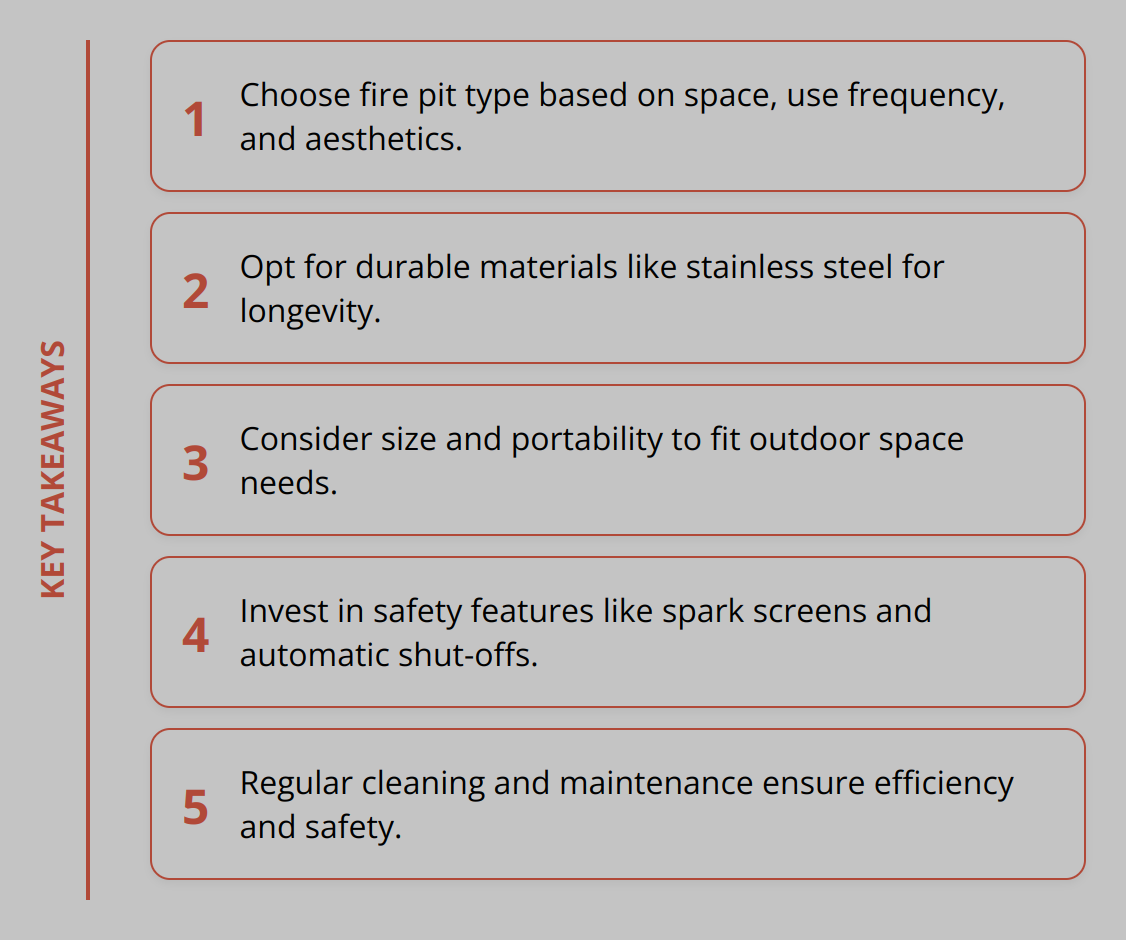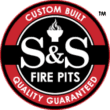
Choosing the perfect fire pit can transform your outdoor space into a cozy, inviting retreat. Here at S&S Fire Pits, we understand the importance of finding a fire pit that not only meets your aesthetic desires but also your functional needs.
This guide is designed to walk you through the essentials: from the types of fire pits available to key features you should consider, and maintenance tips to keep your fire pit in top shape. Our aim is to help you make an informed decision, ensuring you get the most out of your outdoor gatherings for years to come.
Choosing Your Fire Pit
Navigating the diverse world of fire pits is essential to enrich your outdoor space with warmth and style. The ultimate choice boils down to understanding the variants and aligning them with your personal and space needs. Let’s explore the prevalent fire pit types and discern what makes each unique, aiming to steer you towards the perfect addition to your backyard or patio.
Unveiling the Fire Pit Types
Initially, categorize fire pits into three core types: wood-burning, gas, and portable options. Each carries distinct advantages and limitations, pivotal in shaping your decision-making process.
Wood-burning fire pits are the traditional choice, offering an authentic experience with their crackling sounds and the mesmerizing dance of flames. They invite a hands-on interaction, from lighting the fire to stoking it. However, maintenance and smoke output are considerations that might lead some to explore alternatives.
Gas fire pits stand out for their convenience, featuring easy start-ups and minimal cleanup. They provide a continuous flame without the intermittent refueling required by wood-burning units. The downside? They generally require professional installation and, for some, lack the primal allure of wood fires.
Portable fire pits offer flexibility, allowing you to shift the warmth and ambiance to various outdoor locations. Their movability makes them a fit for those with evolving outdoor layout preferences or for adventurers seeking to enhance their camping experience. The trade-off here includes smaller sizes and, often, less heat output compared to their stationary counterparts.

Making the Right Choice
Your decision should pivot around key considerations specific to your outdoor living aspirations:
- Space Availability: Larger areas can accommodate grand wood-burning pits, while compact patios might benefit from sleek gas models or portable fire pits.
- Usage Frequency: For frequent use, the convenience of a gas fire pit might outweigh the charm of wood-burning options.
- Aesthetic and Ambiance: Consider the sensory experiences you value. The rustic allure of wood fires or the clean elegance of gas flames?
- Maintenance Willingness: Wood-burning pits demand regular cleaning and ash disposal, a commitment not everyone prefers.
- Local Regulations: Some areas have restrictions on wood-burning units due to smoke emissions, nudging residents towards gas or smokeless alternatives.
In essence, aligning the fire pit type with your practical needs and aesthetic desires guarantees an outdoor extension that complements your lifestyle. For firsthand insights and additional guidance, exploring how our fire pits are made and beginners’ tips for using a fire pit might offer valuable perspectives.

With an informed choice, your fire pit will not only elevate your outdoor ambiance but also serve as a backdrop for countless memories made under the open sky.
Key Fire Pit Features
When selecting a fire pit, the critical elements that determine its longevity, safety, and suitability for your space are material quality, size, shape, and the inclusion of safety features and accessories. These components significantly affect not only how your fire pit integrates with your outdoor environment but also its ease of use and maintenance.
Material Quality and Durability: The lifeline of any fire pit hinges on its construction material. High-grade materials like stainless steel, cast aluminum, and tempered glass stand up well against the elements, ensuring your fire pit remains a focal point in your garden or patio for years. Stainless steel, for instance, offers rust resistance and longevity, while cast aluminum is lightweight yet sturdy. Opting for durable materials might come with a higher upfront cost, but it reduces the need for frequent replacements or repairs, saving money in the long run.
Size, Shape, and Portability: The spatial dynamics of your outdoor area and how you intend to use the fire pit should guide your choice on its size and shape. A larger, permanent fixture suits spacious yards intended for hosting large gatherings, whereas a compact, portable design is ideal for smaller spaces or for those who prefer the flexibility of moving their fire pit. Square or rectangular fire pits can offer a modern look and fit neatly into certain patio layouts, while circular ones encourage more intimate gatherings.
Safety Features and Accessories: Never compromise on safety. Look for fire pits with stable bases and those that come with spark screens to contain embers. Features like automatic shut-off valves for gas fire pits add an extra layer of safety. Additionally, accessories such as protective covers extend the life of your fire pit by guarding against weather and debris when not in use. Integrating safety features and using protective accessories will not only protect you and your loved ones but also safeguard your investment.

For further details on safely enjoying your fire pit, consider strategies and tips from fire pit safety guidelines. Understanding the best practices for fire pit use ensures you and your family can enjoy your outdoor space securely.
Remember, investing time in choosing the right fire pit by considering these key features simplifies maintenance and maximizes enjoyment of your outdoor living area. Your selection should reflect not just your personal style but also prioritize practicality and safety, ensuring your fire pit serves as a cherished addition to your outdoor spaces for a long time.
Keeping Your Fire Pit in Prime Condition
Ensuring your fire pit remains a centerpiece of your outdoor space for years involves regular maintenance and adherence to safety measures. A well-maintained fire pit not only looks better but also operates more efficiently and safely. Here are practical tips to help you achieve this.
Regular Cleaning is Key
After each use of a wood-burning fire pit, make sure to remove ash and debris when the pit is cool. This prevents accumulation that could impede air flow and efficiency. For gas fire pits, check for debris that might block gas lines and periodically inspect burners for clogs. Regardless of type, a gentle soap and water solution can be used to wipe down exterior surfaces; avoid harsh chemicals that can damage the finish.
For specific cleaning advice on stainless steel and cast aluminum, visiting fire pit care can provide targeted strategies to keep them looking their best.
Safety Measures for Optimal Use
Safety should always be a top priority. For wood fire pits, ensure you’re only burning dry, seasoned wood to minimize smoke and prevent residue buildup. Gas fire pit users should regularly inspect their equipment for leaks. Always check local regulations about fire pit usage to ensure compliance with restrictions and guidelines.
Moreover, positioning your fire pit away from combustible materials (furniture, plants, buildings) and overhead tree branches reduces fire risk. Having a dedicated fire extinguisher or water source nearby provides peace of mind and preparedness for emergencies.
Best Practices for Longevity and Performance
- Use a cover: Protect your fire pit from the elements with a suitable cover, especially during adverse weather conditions or long periods of inactivity. This can prevent rust and debris accumulation.
- Follow manufacturer guidelines: Every fire pit is unique. Adhering to the manufacturer’s instructions for care, maintenance, and operation ensures optimal performance and longevity.
- Quality fuel matters: For wood fire pits, using seasoned hardwoods like oak or maple not only provides a better burning experience but also maintains the pit’s condition. Gas fire pit users should ensure their fuel source is clean and consistent to avoid operational issues.
- Regular inspections: Periodically inspect your fire pit for signs of wear, tear, or damage. Addressing issues early can prevent more significant problems down the line.

Maintaining your fire pit doesn’t just extend its life but enhances safety and enjoyment of your outdoor space. Taking proactive steps in care and maintenance ensures that your fire pit remains an inviting focal point of your backyard gatherings, providing warmth and ambiance reliably whenever you seek the comfort of its glow.
Final Thoughts
Choosing the right fire pit is about blending functionality with aesthetics, ensuring it complements your lifestyle and enhances your outdoor space. Whether you lean towards the traditional ambiance of wood-burning fire pits, the convenience of gas, or the flexibility of portable designs, the perfect fire pit is out there waiting to transform your backyard into a year-round haven for relaxation and entertainment.

Here are our final tips for potential buyers:
- Consider your space and usage to determine the best type and size.
- Prioritize quality materials like those found in S&S Fire Pits to ensure longevity and safety.
- Safety features cannot be overlooked. Opt for fire pits with stable bases and protective screens.
- Maintenance and care are key to preserving your fire pit’s condition.
- Local regulations are a must-check to enjoy your fire pit without legal concerns.
And when you’re ready to find a fire pit that promises durability and timeless design, we invite you to explore the handcrafted, solid steel fire pits at S&S Fire Pits. Our commitment to quality and American craftsmanship ensures each fire pit is a worthy addition to your outdoor living space, guaranteed for life. From classic hemisphere designs to modern elliptical options, plus essential accessories for the ultimate fire pit experience, we’ve got you covered.
Remember, a fire pit is more than just a heating element; it’s a gathering spot, a source of ambience, and a key component in creating lasting memories outdoors. Choose wisely, maintain regularly, and your fire pit will serve as the heart of your backyard for years to come.
Stay safe and enjoy the warmth and beauty your fire pit brings to every outdoor occasion.


